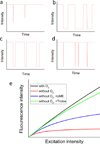Photophysics of fluorescent probes for single-molecule biophysics and super-resolution imaging
- PMID: 22404588
- PMCID: PMC3736144
- DOI: 10.1146/annurev-physchem-032210-103340
Photophysics of fluorescent probes for single-molecule biophysics and super-resolution imaging
Abstract
Single-molecule fluorescence spectroscopy and super-resolution microscopy are important elements of the ongoing technical revolution to reveal biochemical and cellular processes in unprecedented clarity and precision. Demands placed on the photophysical properties of the fluorophores are stringent and drive the choice of appropriate probes. Such fluorophores are not simple light bulbs of a certain color and brightness but instead have their own "personalities" regarding spectroscopic parameters, redox properties, size, water solubility, photostability, and several other factors. Here, we review the photophysics of fluorescent probes, both organic fluorophores and fluorescent proteins, used in applications such as particle tracking, single-molecule FRET, stoichiometry determination, and super-resolution imaging. Of particular interest is the thiol-induced blinking of Cy5, a curse for single-molecule biophysical studies that was later overcome using Trolox through a reducing/oxidizing system but a boon for super-resolution imaging owing to the controllable photoswitching. Understanding photophysics is critical in the design and interpretation of single-molecule experiments.
Figures






References
-
- Joo C, Balci H, Ishitsuka Y, Buranachai C, Ha T. Advances in single-molecule fluorescence methods for molecular biology. Annu Rev Biochem. 2008;77:51–76. - PubMed
Publication types
MeSH terms
Substances
Grants and funding
LinkOut - more resources
Full Text Sources
Other Literature Sources

